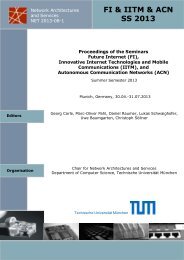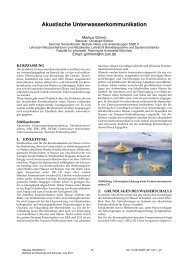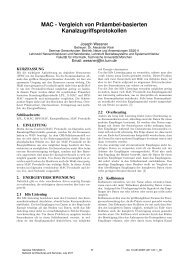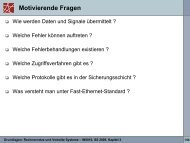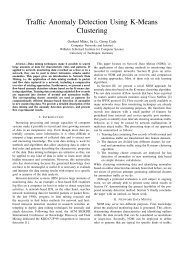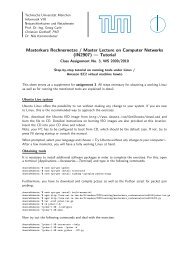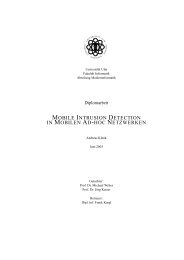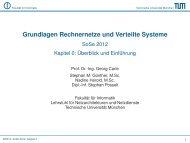Master Course Computer Networks IN2097 - TUM
Master Course Computer Networks IN2097 - TUM
Master Course Computer Networks IN2097 - TUM
Create successful ePaper yourself
Turn your PDF publications into a flip-book with our unique Google optimized e-Paper software.
Chair for Network Architectures and Services – Prof. Carle<br />
Department for <strong>Computer</strong> Science<br />
TU München<br />
<strong>Master</strong> <strong>Course</strong><br />
<strong>Computer</strong> <strong>Networks</strong><br />
<strong>IN2097</strong><br />
Prof. Dr.-Ing. Georg Carle<br />
Christian Grothoff, Ph.D.<br />
Stephan Günther<br />
Andreas Müller (mueller@net.in.tum.de)<br />
Chair for Network Architectures and Services<br />
Institut für Informatik<br />
Technische Universität München<br />
http://www.net.in.tum.de
Recap<br />
q� NAT behavior on outgoing packets and incoming packets<br />
§� Binding: Port and NAT<br />
• Endpoint/Connection independent vs. dependent<br />
§� Filtering: independent vs. (port/address) restricted<br />
§� Processing Model for describing individual steps<br />
q� NAT Traversal Problem<br />
§� Realm specific IP addresses in the payload<br />
§� P2P services<br />
§� Bundled Session Applications<br />
§� Unsupported protocol<br />
q� NAT Traversal techniques<br />
§� Behavior based vs. active support by the NAT/ext. entities<br />
Network <strong>IN2097</strong> - <strong>Master</strong> Security, <strong>Course</strong> WS 2008/09, <strong>Computer</strong> Chapter <strong>Networks</strong>, 9 WS 2012/2013 2
Agenda<br />
q� Skype as one example for an application that<br />
is known to work in many environments<br />
q� Large Scale Network Address Translation<br />
§� At provider side<br />
§� Challenges and approaches<br />
q� Middleboxes<br />
§� Today’s Internet Architecture<br />
§� Classification of and reasons for middleboxes<br />
§� Behavior of middleboxes<br />
§� Concerns<br />
Network <strong>IN2097</strong> - <strong>Master</strong> Security, <strong>Course</strong> WS 2008/09, <strong>Computer</strong> Chapter <strong>Networks</strong>, 9 WS 2012/2013 3
Skype<br />
q� Closed source P2P VoIP and IM Client<br />
q� Many techniques to make reverse engineering difficult<br />
§� Code obfuscation<br />
§� Payload obfuscation<br />
q� Known to work in most environments<br />
q� Extensive use of NAT Traversal techniques<br />
§� STUN<br />
§� Hole Punching<br />
§� Relaying<br />
§� UPnP<br />
§� Port Prediction<br />
Network <strong>IN2097</strong> - <strong>Master</strong> Security, <strong>Course</strong> WS 2008/09, <strong>Computer</strong> Chapter <strong>Networks</strong>, 9 WS 2012/2013 4
„Join“ process<br />
q� Tasks performed<br />
§� User authentication<br />
§� Presence advertisement<br />
§� Determine the type of NAT<br />
§� Discover other Skype nodes<br />
§� Check availability of latest software<br />
q� Needs to connect to at least one SN<br />
§� SNs used for signaling<br />
§� Host Cache holds ~200 SNs<br />
§� 7 Skype bootstrap SN as last resort<br />
http://www.cs.columbia.edu/~salman/publications/skype1_4.pdf<br />
Network <strong>IN2097</strong> - <strong>Master</strong> Security, <strong>Course</strong> WS 2008/09, <strong>Computer</strong> Chapter <strong>Networks</strong>, 9 WS 2012/2013 6
NAT Traversal<br />
q� Ports<br />
§� Randomly chosen (configurable) TCP and UDP port for the<br />
Skype client<br />
§� Additionally: listen at port 80 and 443 if possible<br />
• If you become a SN<br />
• outgoing connections to 80/443 are usually possible for all SCs<br />
q� Skype SNs used as Rendezvous Points<br />
§� SN acts as STUN-like server to determine external mappings<br />
§� Signaling and exchange of public endpoints for HP<br />
§� Used as relays if necessary<br />
§� Otherwise, no centralized NAT helper<br />
Network <strong>IN2097</strong> - <strong>Master</strong> Security, <strong>Course</strong> WS 2008/09, <strong>Computer</strong> Chapter <strong>Networks</strong>, 9 WS 2012/2013 7
Hole Punching in Skype<br />
http://www.heise.de/security/artikel/Klinken-putzen-271494.html<br />
Network <strong>IN2097</strong> - <strong>Master</strong> Security, <strong>Course</strong> WS 2008/09, <strong>Computer</strong> Chapter <strong>Networks</strong>, 9 WS 2012/2013 8
More on Skype<br />
q� http://www.cs.columbia.edu/~salman/skype/<br />
Network <strong>IN2097</strong> - <strong>Master</strong> Security, <strong>Course</strong> WS 2008/09, <strong>Computer</strong> Chapter <strong>Networks</strong>, 9 WS 2012/2013 9
Recap: Problem<br />
q� More and more devices connect to the Internet<br />
§� PCs<br />
§� Cell phones<br />
§� Internet radios<br />
§� TVs<br />
§� Home appliances<br />
§� Future: sensors, cars...<br />
q� IP addresses need to be globally<br />
unique<br />
§� IPv4 provides a 32bit field<br />
§� Many addresses not usable<br />
because of classful allocation<br />
à� We are running out of IP addresses<br />
Network <strong>IN2097</strong> - <strong>Master</strong> Security, <strong>Course</strong> WS 2008/09, <strong>Computer</strong> Chapter <strong>Networks</strong>, 9 WS 2012/2013 10
The problem is becoming even worse<br />
q� More and more devices connect to the Internet<br />
§� PCs<br />
§� Cell phones<br />
§� Internet radios<br />
§� TVs<br />
§� Home appliances<br />
§� Future: sensors, cars...<br />
q� With NAT, every NAT router needs an<br />
IPv4 address<br />
q� à� ISPs run out of global IPv4<br />
addresses<br />
Network <strong>IN2097</strong> - <strong>Master</strong> Security, <strong>Course</strong> WS 2008/09, <strong>Computer</strong> Chapter <strong>Networks</strong>, 9 WS 2012/2013 11
Large Scale NAT (LSN)<br />
q� Facts<br />
§� ISPs run out of global IPv4 addresses<br />
§� Many hosts (in customer‘s network) are IPv4 only<br />
§� Not all content in the web is (and will be) accessible via IPv6<br />
• infact: < 5% of the Top 1M Websites (12/2012)<br />
q� Challenges for ISPs<br />
§� access provisioning for new customers<br />
§� allow customers to use their IPv4 only devices<br />
§� provide access to IPv4 content<br />
q� Approach: move public IPv4 addresses from customer to<br />
provider<br />
§� Large Scale NAT (LSN) / Carrier Grade NAT (CGN)<br />
at provider for translating addresses<br />
Network <strong>IN2097</strong> - <strong>Master</strong> Security, <strong>Course</strong> WS 2008/09, <strong>Computer</strong> Chapter <strong>Networks</strong>, 9 WS 2012/2013 12
Large Scale NAT already common today<br />
Network <strong>IN2097</strong> - <strong>Master</strong> Security, <strong>Course</strong> WS 2008/09, <strong>Computer</strong> Chapter <strong>Networks</strong>, 9 WS 2012/2013 13
Example – Vodafone LTE network<br />
q� Algorithm to detect network topology<br />
§� <strong>Master</strong> thesis Florian Wohlfart 2012<br />
q� LTE network for remote areas are usually double NATed<br />
q� Test Server @<strong>TUM</strong>, Client in Vodafone LTE network (17 hops)<br />
Network <strong>IN2097</strong> - <strong>Master</strong> Security, <strong>Course</strong> WS 2008/09, <strong>Computer</strong> Chapter <strong>Networks</strong>, 9 WS 2012/2013 14
Topology detection algorithm<br />
1) Establish state in<br />
all hops by sending<br />
outgoing packets<br />
2) Count number of<br />
hops towards server<br />
3) Remove mappings<br />
hop by hop<br />
3) count number of hops<br />
towards server<br />
if stateful hop (e.g. NAT)<br />
less hops detected<br />
Network <strong>IN2097</strong> - <strong>Master</strong> Security, <strong>Course</strong> WS 2008/09, <strong>Computer</strong> Chapter <strong>Networks</strong>, 9 WS 2012/2013 15
NAT 444<br />
Network <strong>IN2097</strong> - <strong>Master</strong> Security, <strong>Course</strong> WS 2008/09, <strong>Computer</strong> Chapter <strong>Networks</strong>, 9 WS 2012/2013 16
NAT 444<br />
q� Easiest way to support new customers<br />
§� immediately available<br />
§� no changes at CPEs (Customer Premises Equipment)<br />
q� Problems:<br />
§� Address overlap à� same private IP address on both sides<br />
§� Firewalls on CPE may block incoming packets with a private<br />
source address<br />
q� Solutions<br />
§� declare a range of public IP addresses as „ISP shared“ and reuse it<br />
as addresses between CGN and CPE<br />
§� NAT 464: IPv6 between CPE and CGN<br />
• Problem: CPEs must implement NAT64<br />
Network <strong>IN2097</strong> - <strong>Master</strong> Security, <strong>Course</strong> WS 2008/09, <strong>Computer</strong> Chapter <strong>Networks</strong>, 9 WS 2012/2013 17
NAT 464<br />
Network <strong>IN2097</strong> - <strong>Master</strong> Security, <strong>Course</strong> WS 2008/09, <strong>Computer</strong> Chapter <strong>Networks</strong>, 9 WS 2012/2013 18
Dual Stack Lite<br />
q� Mixture of NAT 444 and NAT 464<br />
q� IPv4 in IPv6 tunnel between CPE and ISP<br />
§� No need for protocol translation<br />
§� No cascaded NATs<br />
q� Allows to deploy IPv6 in the ISP network while still<br />
supporting IPv4 content and IPv4 customers<br />
§� As IPv6 devices become available they can be directly<br />
connected without the need for a tunnel<br />
q� Pushed by Juniper, Cisco, Comcast and Apple<br />
§� IETF RFC 6333<br />
Network <strong>IN2097</strong> - <strong>Master</strong> Security, <strong>Course</strong> WS 2008/09, <strong>Computer</strong> Chapter <strong>Networks</strong>, 9 WS 2012/2013 19
Dual Stack Lite<br />
Network <strong>IN2097</strong> - <strong>Master</strong> Security, <strong>Course</strong> WS 2008/09, <strong>Computer</strong> Chapter <strong>Networks</strong>, 9 WS 2012/2013 20
LSN/CGN Challenges<br />
q� As currently discussed in the IETF BEHAVE working group<br />
q� Mainly: how to manage resources<br />
§� Ports (number of ports, allocation limit (time))<br />
§� Addresses<br />
§� Bandwidth<br />
§� legal issues (logging)<br />
q� NAT behavior<br />
§� desired: first packet reserves a bin for the customer -> less logging effort<br />
§� IP address pooling: random vs. paired (same external IP for internal host)<br />
q� Impacts of double NAT for users<br />
§� Blacklisting as done today (based on IP addressed) will be a problem<br />
§� No control of ISP NATs<br />
q� Possible Approaches<br />
§� Small static pool of ports in control of customer<br />
§� Needs configuration/reservation/security protocols<br />
Network <strong>IN2097</strong> - <strong>Master</strong> Security, <strong>Course</strong> WS 2008/09, <strong>Computer</strong> Chapter <strong>Networks</strong>, 9 WS 2012/2013 21
Network Address Translation today<br />
q� Thought as a temporary solution<br />
q� Home Users<br />
q� ISPs<br />
§� to share one public IP address<br />
§� to hide the network topology and to provide some sort of security<br />
§� for connecting more and more customers<br />
§� for the planned transition to IPv6<br />
q� Mobile operators<br />
§� to provide connectivity to a large number of customers<br />
§� „security“<br />
q� Enterprises<br />
§� to hide their topology<br />
§� to be address independent<br />
Network <strong>IN2097</strong> - <strong>Master</strong> Security, <strong>Course</strong> WS 2008/09, <strong>Computer</strong> Chapter <strong>Networks</strong>, 9 WS 2012/2013 22
NAT Conclusion<br />
q� NAT helps against the shortage of IPv4 addresses<br />
q� NAT works as long as the server part is in the public internet<br />
q� P2P communication across NAT is difficult<br />
q� NAT behavior is not standardized<br />
§� keep that in mind when designing a protocol<br />
q� many solutions for the NAT-Traversal problem<br />
§� none of them works with all NATs<br />
§� framework can select the most appropriate technique<br />
q� New challenges with the transition to IPv6 and LSN/CGN<br />
§� Topology becomes important<br />
Network <strong>IN2097</strong> - <strong>Master</strong> Security, <strong>Course</strong> WS 2008/09, <strong>Computer</strong> Chapter <strong>Networks</strong>, 9 WS 2012/2013 23
Chair for Network Architectures and Services – Prof. Carle<br />
Department for <strong>Computer</strong> Science<br />
TU München<br />
Middleboxes
Internet Architecture<br />
q� Initial end-to-end principle<br />
§� Saltzer, Reed and Clark (1984)<br />
“certain functionality can only be<br />
implemented correctly with the<br />
knowledge and help of the<br />
application standing at the end<br />
points of the communication<br />
system.”<br />
§� Hosts in the Internet<br />
only for routing and forwarding<br />
§� No state otherwise<br />
q� Today<br />
§� Intermediate hosts<br />
offer additional<br />
functionality<br />
Network <strong>IN2097</strong> - <strong>Master</strong> Security, <strong>Course</strong> WS 2008/09, <strong>Computer</strong> Chapter <strong>Networks</strong>, 9 WS 2012/2013 25
Some Reasons for today’s architecture<br />
q� Independent Autonomous Systems<br />
§� ISPs ran as businesses<br />
§� Interconnection driven by contracts rather than performance<br />
§� Discussion about network neutrality<br />
q� Lack of Security<br />
§� Not part of the initial (end-to-end) architecture<br />
§� Security should be implemented on end-hosts only<br />
§� Often solved by introducing additional functionality to the network<br />
(Firewalls, Intrusion Detection Systems…)<br />
q� Protection of Innovation<br />
§� Initially: changes only in the end-hosts<br />
§� Today: changes in the end-hosts hard due to heterogeneity of<br />
devices/operating systems<br />
à� additional functionality as a black box in the network<br />
Network <strong>IN2097</strong> - <strong>Master</strong> Security, <strong>Course</strong> WS 2008/09, <strong>Computer</strong> Chapter <strong>Networks</strong>, 9 WS 2012/2013 26
Recent Study by UCL (2011)<br />
q� Marc Handley et al. (University College London)<br />
§� “Flow processing and the rise of the middle”<br />
§� “Is it still possible to extend TCP?” (SIGCOMM 2011)<br />
q� Ran tests to measure what happens to TCP in the Internet<br />
§� e.g. Are new TCP options permitted (options field)?<br />
§� Are sequence numbers modified?<br />
q� 142 access networks in 24 countries<br />
§� 25% of paths interfered with TCP in some way beyond basic<br />
firewalling.<br />
§� 20% remove new TCP options on port 80 (only 4% on port 34343)<br />
§� 18% rewrite sequence numbers (initial sequence numbers differ)<br />
à� Many black boxes in the network, especially for HTTP<br />
Network <strong>IN2097</strong> - <strong>Master</strong> Security, <strong>Course</strong> WS 2008/09, <strong>Computer</strong> Chapter <strong>Networks</strong>, 9 WS 2012/2013 27
Netalyzr (ICSI, Berkeley)<br />
q� Network Measurement and Debugging Service<br />
§� http://netalyzr.icsi.berkeley.edu/<br />
q� Web-based (JAVA Applet) testing<br />
§� Port filtering<br />
§� HTTP caches and proxies<br />
§� DNS manipulation<br />
§� Network Buffers<br />
§� Fragmentation and Buffers<br />
q� Selected Results (130k measurements, IMC Paper 2010)<br />
§� 90% of all sessions behind NAT, 80%: 192/168 range<br />
§� SMTP blocked for 25%, FTP for 20%<br />
§� 8.4% implement HTTP Proxy<br />
Network <strong>IN2097</strong> - <strong>Master</strong> Security, <strong>Course</strong> WS 2008/09, <strong>Computer</strong> Chapter <strong>Networks</strong>, 9 WS 2012/2013 28
Middleboxes<br />
q� The phrase "middlebox" was coined by<br />
Lixia Zhang (UCLA)<br />
q� RFC 3234 defines middleboxes as:<br />
“intermediary devices performing functions other than the normal,<br />
standard functions of an IP router on the datagram path between a<br />
source host and destination host”<br />
q� Middleboxes are never the end-system of an application<br />
session and may<br />
§� drop<br />
§� insert<br />
§� transform<br />
§� and modify packets<br />
Network <strong>IN2097</strong> - <strong>Master</strong> Security, <strong>Course</strong> WS 2008/09, <strong>Computer</strong> Chapter <strong>Networks</strong>, 9 WS 2012/2013 29
Middleboxes often address practical challenges<br />
q� “Plenty of box vendors will sell you a solution…<br />
Whatever you think your problem is.” (Mark Handley, UCL)<br />
q� IP address depletion<br />
§� Allowing multiple hosts to share a single address<br />
q� Host mobility<br />
§� Relaying traffic to a host in motion<br />
q� Security concerns<br />
§� Discarding suspicious or unwanted packets<br />
§� Detecting suspicious traffic<br />
q� Performance concerns<br />
§� Controlling how link bandwidth is allocated<br />
§� Storing popular content near the clients<br />
Network <strong>IN2097</strong> - <strong>Master</strong> Security, <strong>Course</strong> WS 2008/09, <strong>Computer</strong> Chapter <strong>Networks</strong>, 9 WS 2012/2013 30
RFC 3234 - Middleboxes: Taxonomy and Issues<br />
q� Gives an overview about current middleboxes<br />
1) Layer of Operation (ISO/OSI)<br />
2) Transparency<br />
§� Part of the protocol (not transparent) or transparent<br />
3) Purpose<br />
§� Functional (part of the application) vs. Optimizing (addition)<br />
4) Operation<br />
§� Routing (plain forwarding) or Processing of packets<br />
5) Stateful or stateless<br />
Network <strong>IN2097</strong> - <strong>Master</strong> Security, <strong>Course</strong> WS 2008/09, <strong>Computer</strong> Chapter <strong>Networks</strong>, 9 WS 2012/2013 31
Middlebox Functionality according to RFC 3234<br />
Layer Transparency Purpose Operation State<br />
Reason for Introduction: Address depletion<br />
NAT 3+4 Transparent Functional Processing Stateful<br />
Other examples: NAT44 with ALG<br />
Reason for Introduction: Security<br />
Firewall 3+4 Transparent Functional Routing Stateful<br />
Other examples: Deep Packet Inspection, Anonymizer, Tunnel Endpoint<br />
Reason for Introduction: Performance<br />
Web-Cache 7 both both Processing Stateless<br />
Other examples: Proxy<br />
Network <strong>IN2097</strong> - <strong>Master</strong> Security, <strong>Course</strong> WS 2008/09, <strong>Computer</strong> Chapter <strong>Networks</strong>, 9 WS 2012/2013 32
Middlebox behavior not standardized<br />
q� Just like NAT (as one middlebox example)<br />
q� Many possibilities to implement practically the same functionality<br />
§� e.g. address translation<br />
§� But many ways of allocating new mappings<br />
q� Idea: If exact behavior is understood and if can be expressed,<br />
coping with middleboxes becomes easier<br />
q� Model for formalizing and describing middlebox behavior<br />
§� Measure behavior and create model<br />
§� Model holds properties of the middlebox<br />
§� Traversal solutions based on model<br />
Network <strong>IN2097</strong> - <strong>Master</strong> Security, <strong>Course</strong> WS 2008/09, <strong>Computer</strong> Chapter <strong>Networks</strong>, 9 WS 2012/2013 33
NAT Analyzer – Measuring NAT and MB Behavior<br />
q� Public field test with more than 4000 NATs<br />
§� understand existing traversal techniques and NAT behavior<br />
(http://nattest.net.in.tum.de)<br />
Network <strong>IN2097</strong> - <strong>Master</strong> Security, <strong>Course</strong> WS 2008/09, <strong>Computer</strong> Chapter <strong>Networks</strong>, 9 WS 2012/2013 34
Field Test<br />
q� Idea: ask volunteers to run the algorithms in their network<br />
Network <strong>IN2097</strong> - <strong>Master</strong> Security, <strong>Course</strong> WS 2008/09, <strong>Computer</strong> Chapter <strong>Networks</strong>, 9 WS 2012/2013 35
NAT Analyzer<br />
q� Connectivity tests with a server at <strong>TUM</strong> reveals<br />
§� NAT Type<br />
§� Mapping strategy<br />
§� Binding Strategy<br />
§� Hole Punching behavior using different techniques<br />
§� Timeouts<br />
§� ALGs<br />
q� Example<br />
Result<br />
Network <strong>IN2097</strong> - <strong>Master</strong> Security, <strong>Course</strong> WS 2008/09, <strong>Computer</strong> Chapter <strong>Networks</strong>, 9 WS 2012/2013 36
NAT Analyzer– Results (World)<br />
Network <strong>IN2097</strong> - <strong>Master</strong> Security, <strong>Course</strong> WS 2008/09, <strong>Computer</strong> Chapter <strong>Networks</strong>, 9 WS 2012/2013 37
NAT Analyzer– Results (Central Europe)<br />
Network <strong>IN2097</strong> - <strong>Master</strong> Security, <strong>Course</strong> WS 2008/09, <strong>Computer</strong> Chapter <strong>Networks</strong>, 9 WS 2012/2013 38
Success Rates for existing traversal solutions<br />
q� UPnP 31 %<br />
q� Hole Punching<br />
§� UDP 80%<br />
§� TCP low TTL 62%<br />
§� TCP high TTL 52%<br />
§� TCP combined 67%<br />
q� Relay 100%<br />
q� Probabilities for a direct connection<br />
§� UDP Traversal: 85 %<br />
§� TCP Traversal: 82 %<br />
§� TCP inclusive tunneling: 95 %<br />
Network <strong>IN2097</strong> - <strong>Master</strong> Security, <strong>Course</strong> WS 2008/09, <strong>Computer</strong> Chapter <strong>Networks</strong>, 9 WS 2012/2013 39
NAT Binding Results - Recap<br />
q� NAT Binding:<br />
§� two consecutive connections from the same source to different<br />
destinations create two external mappings X and Y<br />
• Endpoint independent: X == Y<br />
• Connection dependent: X != Y<br />
q� Problem:<br />
§� Connection dependent binding hard to predict<br />
• STUN not possible<br />
q� Goal: Improve Port Prediction for connection dependent binding<br />
§� Send two packets from same source port to STUN-like<br />
server, look at the two different external ports and calculate<br />
difference<br />
• e.g. extPort 1 = 20000, extPort2=20001 à� difference = 1<br />
Network <strong>IN2097</strong> - <strong>Master</strong> Security, <strong>Course</strong> WS 2008/09, <strong>Computer</strong> Chapter <strong>Networks</strong>, 9 WS 2012/2013 40
Connection dependent binding<br />
Network <strong>IN2097</strong> - <strong>Master</strong> Security, <strong>Course</strong> WS 2008/09, <strong>Computer</strong> Chapter <strong>Networks</strong>, 9 WS 2012/2013 41
Connection dependent binding (2)<br />
27%<br />
8%<br />
17%<br />
57%<br />
Network <strong>IN2097</strong> - <strong>Master</strong> Security, <strong>Course</strong> WS 2008/09, <strong>Computer</strong> Chapter <strong>Networks</strong>, 9 WS 2012/2013 42
Binding Analysis Results<br />
q� State of the Art<br />
§� Connection dependent binding (Symmetric NAT)<br />
is hard to traverse<br />
§� Cannot query external port using STUN and reuse<br />
it for an actual connection<br />
q� Field Test results<br />
§� 22% for UDP and 25% for TCP implement<br />
connection dependent binding<br />
§� In 57% for UDP (44% for TCP) port prediction is<br />
possible by analyzing binding patterns<br />
q� Question: How to express this information?<br />
Network <strong>IN2097</strong> - <strong>Master</strong> Security, <strong>Course</strong> WS 2008/09, <strong>Computer</strong> Chapter <strong>Networks</strong>, 9 WS 2012/2013 43
Approach: Information Model<br />
q� Describes characteristics and behavior properties<br />
§� measured in our field test and from the state of the art<br />
q� XML Schema<br />
q� Model instance describes middlebox behavior<br />
Network <strong>IN2097</strong> - <strong>Master</strong> Security, <strong>Course</strong> WS 2008/09, <strong>Computer</strong> Chapter <strong>Networks</strong>, 9 WS 2012/2013 44
Stateful Element<br />
q� Stateful middleboxes maintain state tables<br />
§� e.g. NAT mapping table<br />
q� Size and strategy (what happens if table is full) depends on<br />
resources and implementation (Stateful:StateTable)<br />
q� State entries expire after a certain amount of time (StateTimer)<br />
Network <strong>IN2097</strong> - <strong>Master</strong> Security, <strong>Course</strong> WS 2008/09, <strong>Computer</strong> Chapter <strong>Networks</strong>, 9 WS 2012/2013 45
Stateful Element (2)<br />
q� State is removed on certain events / packet sequences<br />
(StateRemovePolicy)<br />
q� MB may send packets as a response to packets sent to a non<br />
existing mapping – e.g. TCP RST (NoStatePolicy)<br />
q� Very important for hole punching!<br />
Network <strong>IN2097</strong> - <strong>Master</strong> Security, <strong>Course</strong> WS 2008/09, <strong>Computer</strong> Chapter <strong>Networks</strong>, 9 WS 2012/2013 46
Filtering Element<br />
q� Based on state (State-based)<br />
§� Independent, Address Restricted, Port Restricted<br />
q� Unusual Sequences, e.g. SYN out, SYN in (Protocol-based)<br />
q� Based on a (user-defined) policy (Policy-based)<br />
Network <strong>IN2097</strong> - <strong>Master</strong> Security, <strong>Course</strong> WS 2008/09, <strong>Computer</strong> Chapter <strong>Networks</strong>, 9 WS 2012/2013 47
Translation and Modification<br />
q� For NAT: how to allocate external mappings<br />
§� See last week’s slides for binding etc.<br />
§� Address Pooling: see Large Scale NAT (multiple ext. IP addr)<br />
q� Mapping: correlation of internal and external mappings<br />
§� Mainly: is port prediction possible<br />
Network <strong>IN2097</strong> - <strong>Master</strong> Security, <strong>Course</strong> WS 2008/09, <strong>Computer</strong> Chapter <strong>Networks</strong>, 9 WS 2012/2013 48
Middlebox Instance<br />
q� XML Schema<br />
à� Description results in XML file<br />
Network <strong>IN2097</strong> - <strong>Master</strong> Security, <strong>Course</strong> WS 2008/09, <strong>Computer</strong> Chapter <strong>Networks</strong>, 9 WS 2012/2013 49
Middlebox Instance (cont)<br />
Network <strong>IN2097</strong> - <strong>Master</strong> Security, <strong>Course</strong> WS 2008/09, <strong>Computer</strong> Chapter <strong>Networks</strong>, 9 WS 2012/2013 50
Implication of Middlebox Behavior for Traversal<br />
q� State of the Art (e.g. ICE, Skype)<br />
§� Trial and error<br />
§� “brute force” pairing of endpoints<br />
q� Goal: Traversal based on requester’s and service’s model<br />
§� Pairing based on knowledge<br />
Network <strong>IN2097</strong> - <strong>Master</strong> Security, <strong>Course</strong> WS 2008/09, <strong>Computer</strong> Chapter <strong>Networks</strong>, 9 WS 2012/2013 51
UDP Hole Punching Example<br />
q� initial packet creates state<br />
and gets dropped at remote host<br />
q� remote host may send ICMP<br />
dest. unreachable as a reply<br />
q� requester’s NAT may drop<br />
state if such a packet is seen<br />
q� Alternative: set low TTL<br />
and provoke ICMP TTL exceeded<br />
1) assess predictability of external mappings<br />
Restricted filtering at service needs more accurate prediction<br />
(requesters IP addr. + port) than independent filtering<br />
2) prevent state from being closed by accident<br />
Does answer to hole punching packet close mapping at service?<br />
Network <strong>IN2097</strong> - <strong>Master</strong> Security, <strong>Course</strong> WS 2008/09, <strong>Computer</strong> Chapter <strong>Networks</strong>, 9 WS 2012/2013 52
Step 1) Endpoint predictability<br />
q� Either via STUN or via Port Prediction Algorithm<br />
q� Endpoint predictable on service and requester à� no problem<br />
q� If one is not able to predict endpoint<br />
à� also consider filtering and swap role if necessary<br />
Part 1<br />
Network <strong>IN2097</strong> - <strong>Master</strong> Security, <strong>Course</strong> WS 2008/09, <strong>Computer</strong> Chapter <strong>Networks</strong>, 9 WS 2012/2013 53
Step 2) Prevent State from being closed<br />
q� If requester sends ICMP unreachable as a response to a<br />
received UDP packet for a non-existing state (1)<br />
and Service removes mapping on ICMP unreachable in (2)<br />
try to set a lower TTL (3)<br />
(3)<br />
(2)<br />
(1)<br />
Network <strong>IN2097</strong> - <strong>Master</strong> Security, <strong>Course</strong> WS 2008/09, <strong>Computer</strong> Chapter <strong>Networks</strong>, 9 WS 2012/2013 54
General Concerns with Middleboxes<br />
q� New middleboxes challenge old protocols<br />
§� Protocols designed without consideration of middleboxes<br />
may fail, predictably or unpredictably<br />
q� Middleboxes introduce new failure modes;<br />
rerouting of IP packets around crashed routers is no longer the<br />
only case to consider. The fate of sessions involving<br />
crashed middleboxes must also be considered.<br />
q� Configuration is no longer limited to the two ends of a session;<br />
middleboxes may also require configuration and management.<br />
q� Diagnosis of failures and misconfigurations is more complex.<br />
Network <strong>IN2097</strong> - <strong>Master</strong> Security, <strong>Course</strong> WS 2008/09, <strong>Computer</strong> Chapter <strong>Networks</strong>, 9 WS 2012/2013 55
Assessment<br />
q� Future application protocols should be designed in recognition<br />
of the likely presence of middleboxes (e.g. network address<br />
translation, packet diversion, and packet level firewalls)<br />
q� Approaches for failure handling needed<br />
§� soft state mechanisms<br />
§� rapid failover or restart mechanisms<br />
q� Common features available to many applications needed<br />
§� Middlebox discovery and monitoring<br />
§� Middlebox configuration and control<br />
§� Routing preferences<br />
§� Failover and restart handling<br />
§� Security<br />
Network <strong>IN2097</strong> - <strong>Master</strong> Security, <strong>Course</strong> WS 2008/09, <strong>Computer</strong> Chapter <strong>Networks</strong>, 9 WS 2012/2013 56
Conclusion<br />
q� Middleboxes violate the initial end-to-end argument<br />
q� In many cases: valid reason for introduction<br />
§� Address depletion<br />
§� Security<br />
§� Performance<br />
q� Cause problems with many existing protocols<br />
q� If behavior is known, algorithms can be adapted accordingly<br />
§� Information Model (also processing model)<br />
§� Pairing based on knowledge<br />
Network <strong>IN2097</strong> - <strong>Master</strong> Security, <strong>Course</strong> WS 2008/09, <strong>Computer</strong> Chapter <strong>Networks</strong>, 9 WS 2012/2013 57



